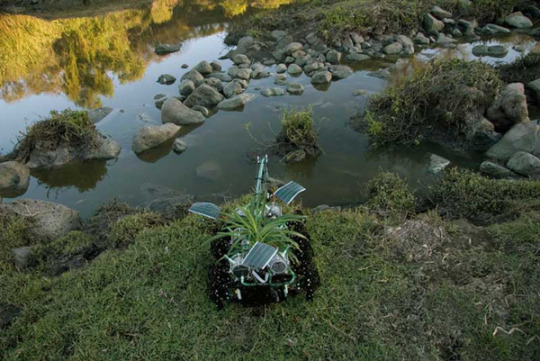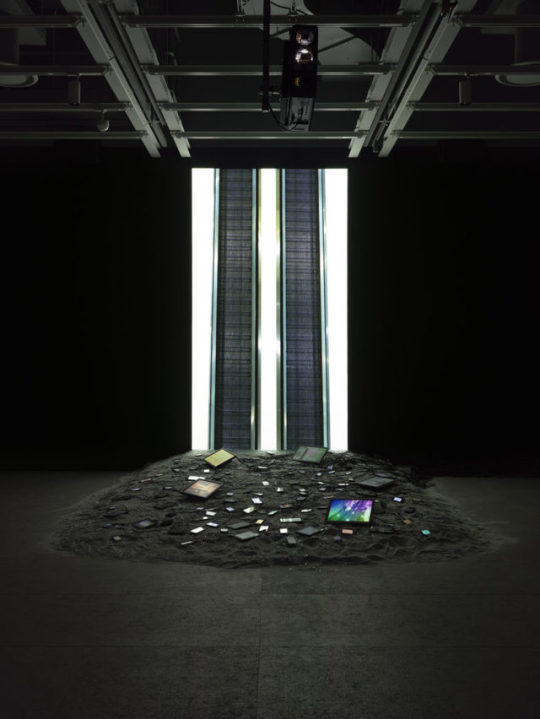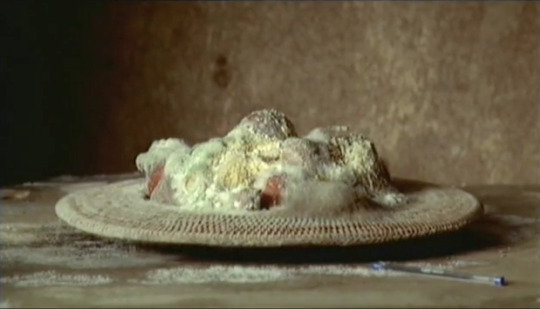Link

Gilberto Esparza (Mexico) - Plantas Nomadas [2010]
Esparza told Iconeye: “Nowadays robots are a waste of energy: they dance and they move all the time.” To make his plant robot self-sufficient but also productive, he designed it so it runs on bacteria found in waste. “When these microorganisms need nourishment the machine seeks out dirty water, which is then decomposed to create energy; any surplus is used to emit a noise and sustain plants carried on its back. The machine and plants becomes co-dependent.”
Decay is a natural process, but it can be accelerated through “unnatural” means. With our assistance, our environment is decaying at a rate faster than it is able to recover on its own. Esparza creates a robot that subsists on our pollution--our engine of rapid environmental decay.
More images
1 note
·
View note
Video
vimeo
Rafael Lozano-Hemmer - Tape Recorders [2011]
Entropy is not decay. Decay is a symptom of, or maybe the manifestation of entropy.
When any given tape recorder reaches its zenith, it crashes down. This is not a traditional image of decay. Decay is a gradual, perceptible process, but the tape recorder collapses all at once. Decay can be invisible, only noticed at a point of critical mass of accumulated decay.
2 notes
·
View notes
Video
vimeo
Ziv Cohen - Long Memory [2016] (SAIC alum. MFA 2018)
When a hard disk drive dies, it actually becomes more animated. Its dancing arm can longer read the spinning disk sequentially.
0 notes
Link
http://cenblog.org/artful-science/2011/07/18/plastics-denial-syndrome/
Sometime during the 1960s, artists en masse began using plastics to make art–a trend that continues today.
The problem is that many plastic polymers have a shelf life of just a decade or so, after which they begin to crumble or crack. Consider an old rubber band or a plastic bottle left out in the sun.
...
Yet in the 1970s, 80s and early 90s, just as plastic sculptures and designer furniture were pouring in to museum and gallery collections, staff conservators were collectively sticking their heads in the sand about the inherent vulnerability of these objects… I mean, even though plastics have short lifespans, there are ways to extend them. But conservators weren’t acknowledging that plastics were problematic.
...
Case in point: the phthalate plasticizer added to make PVC (polyvinyl chloride) maleable has a tendency to leach out, so much so that small pools of the plasticizer collect in and around the art. These plasticizer puddles are not precisely aesthetically pleasing, they attract dust and actually the loss of the plasticizer destabilizes the plastic making it vulnerable to cracking.
0 notes
Photo

Sophia Al-Maria - Black Friday [2016]
In Al-Maria’s view, the mall in both the Gulf and the United States—along with its attendant consumerism—occupies "a weirdly neutral shared zone between cultures that are otherwise engaged in a sort of war of information and image," waged through both traditional and social media. The proliferation of malls in the Gulf in the late 1990s and early 2000s is something Al-Maria witnessed firsthand, having been raised between Washington State and Qatar. Her new video, Black Friday, is a rumination on shopping malls everywhere as secular temples of capitalism. Beneath the projected video lies The Litany, an installation of flickering electronic devices displaying short, glitchy loops—a heap of old screens that acts as a coded history of consumption, conflict, and desire.
https://whitney.org/Exhibitions/SophiaAlMaria
The piece imposes; a grave for a giant. It conjures forth imagery of Borges’ tattered territory-covering map, though instead of tattered paper remains, we Animals and Beggars stumble upon iPhones with cracked screens displaying Google Maps.
Buried in the sand as they are, the screens suggest a human-less post-apocalyptic wasteland, though somehow magically, the screens remain on and functioning without us. All decays inevitably--biological or plastic, but some inevitabilities arrive sooner. This is but a snapshot of decay. An aesthetic of decay.
0 notes
Link

Sam Taylor-Johnson - Still Life, 2001
Shot on 35mm. The enduring Bic pen in the frame stands in sharp contrast to the rapid decay of the stereotypical still-life assemblage.
*Note: does anyone know where I can buy this piece (for cheap)? I’m going to make a piece in a few decades where I screen the deteriorated film reel at the point in the film reel’s life where you can’t tell what the content is anymore. Let me know.
0 notes
Photo

This infographic was produced by the company ‘CrashPlan’ which offers businesses Cloud data storage. It breaks down the longevity of various kinds of physical data storage media used throughout history. Interestingly, the infographic touts The Cloud as capable of storing things infinitely, but the Cloud depends on the same hard drives marked for death in the rest of the graphic. I guess The Cloud is not simply the massive amount of physical storage in an air-conditioned warehouse somewhere, but also the processes that perpetually swap out the dead hard drives for new ones.
Image credit: http://coolinfographics.com/blog/2012/8/14/the-lifespan-of-storage-media.html
0 notes
